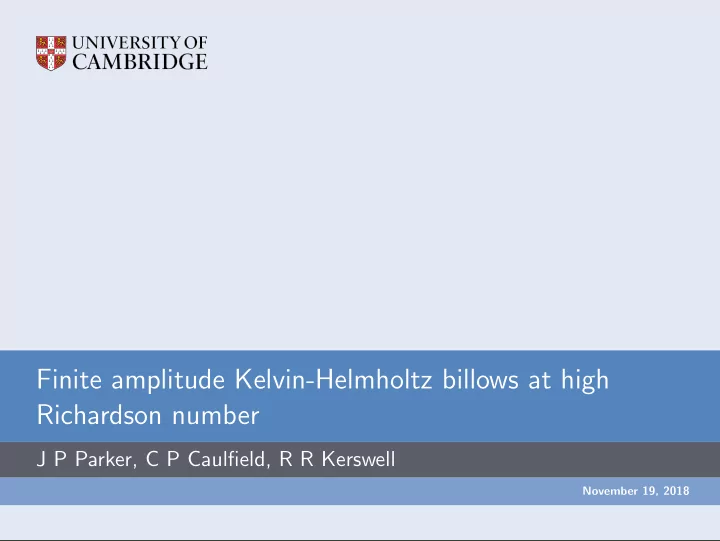

Finite amplitude Kelvin-Helmholtz billows at high Richardson number J P Parker, C P Caulfield, R R Kerswell November 19, 2018
Stratified shear flow 4 ∂ u ∂ t + u · ∇ u = −∇ p + Ri b b e z + 1 Re ∇ 2 u 2 ∂ b ∂ t + u · ∇ b = 1 Re ∇ 2 b u b - 1.0 - 0.5 0.5 1.0 ∇ · u = 0 - 2 - 4 ( Pr = 1) 2 of 13
Richardson Number The Richardson number Ri is the non-dimensional ratio of buoyancy to shear. It is important to distinguish the gradient (local) Richardson number ∂ b /∂ z Ri g = ( ∂ u /∂ z ) 2 Ri b from the bulk Richardson number Ri b , a parameter. 3 of 13
Miles-Howard Theorem For a steady, one-dimensional, Boussinesq, inviscid, stratified shear flow, linear stability is guaranteed if Ri g > 1 / 4 everywhere. “Sufficiently strong stratification enforces stability.” Ri = 1 / 4 is often seen as a magic number in oceanography, and is used in parameterisations, despite the limited scope of the theorem. 4 of 13
Forced equations ∂ u ∂ t + u · ∇ u = −∇ p + Ri b b e z + 1 Re ∇ 2 u + 2 Re tanh ( z ) sech 2 ( z ) e x ∂ b ∂ t + u · ∇ b = 1 Re ∇ 2 b + 2 Re tanh ( z ) sech 2 ( z ) ∇ · u = 0 Steady solution u = e x tanh z b = tanh z 5 of 13
State tracking Formally define F : ( u ( T ) , b ( T )) = F ( u (0) , b (0) , T ) Look for steady states F ( u , b , T ) = ( u , b ) , ∀ T . For simplicity, let X = ( u , b ). Pick arbitrary T , find zeros of G ( X ) ≡ F ( X ) − X 6 of 13
Newton-GMRES To solve G ( X ) = 0 use Newton iteration G X ( X n ) · ( X n +1 − X n ) = − G ( X n ) . To solve linear system at each step using GMRES, need only know G X ( X ) · Y ≈ G ( X + ǫ Y ) − G ( X ) ǫ 7 of 13
Results ( Re = 1000) stable one unstable direction two unstable directions X Ri b Stability analysis performed with Arnoldi iteration. 8 of 13
Results ( Re = 1000) stable one unstable direction two unstable directions X ? Ri b 9 of 13
Bifurcation point tracking At pitchfork/saddle-node bifurcation, attempt to solve F ( X , Ri b ) = X F X ( X , Ri b ) · Y = Y Y · A = 1 for X , Y and Ri b , where A is some fixed direction. Similar for Hopf bifurcation, with 3 time integrations. 10 of 13
Results Ri b 1/2000 1/5000 1/1000 1/500 1/ Re 11 of 13
Conclusions ◮ Non-trivial steady states and complex behaviour are possible at Ri > 1 / 4. ◮ States only just go past 1 / 4. stable one unstable direction two unstable directions X Ri b jpp39@cam.ac.uk 12 of 13
Open questions ◮ How relevant is forced system? ◮ What are the effects of Pr ? 13 of 13
Recommend
More recommend